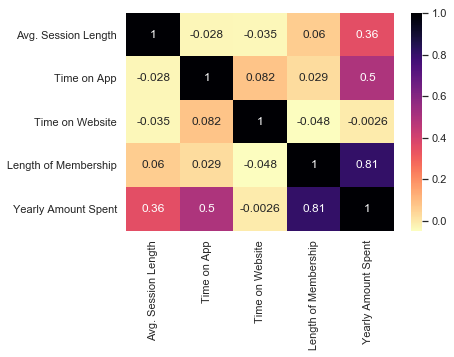Project: Predicting Amount spent
For this project, we are going to use this dataset from Kaggle. This data is of ecommerce customers and their usage on app vs website. Our mission is to comeup with a model that will predict the ‘Yearly Amount Spent’ by the customers based on the given features.
Highlights:
- Exploratory data analysis
- Creating pipeline
- Using LinearRegression model
- Using cross-validation scores to measure model performance
#Imports
import numpy as np
import pandas as pd
#Visualization imports
import matplotlib.pyplot as plt
import seaborn as sns
%matplotlib inline
sns.set()
#import data
ecommerce = pd.read_csv('ecommerce')
#Glimpse of data
ecommerce.head(2)
| Address | Avatar | Avg. Session Length | Time on App | Time on Website | Length of Membership | Yearly Amount Spent | ||
|---|---|---|---|---|---|---|---|---|
| 0 | mstephenson@fernandez.com | 835 Frank Tunnel\nWrightmouth, MI 82180-9605 | Violet | 34.497268 | 12.655651 | 39.577668 | 4.082621 | 587.951054 |
| 1 | hduke@hotmail.com | 4547 Archer Common\nDiazchester, CA 06566-8576 | DarkGreen | 31.926272 | 11.109461 | 37.268959 | 2.664034 | 392.204933 |
#Data info
ecommerce.info()
<class 'pandas.core.frame.DataFrame'>
RangeIndex: 500 entries, 0 to 499
Data columns (total 8 columns):
Email 500 non-null object
Address 500 non-null object
Avatar 500 non-null object
Avg. Session Length 500 non-null float64
Time on App 500 non-null float64
Time on Website 500 non-null float64
Length of Membership 500 non-null float64
Yearly Amount Spent 500 non-null float64
dtypes: float64(5), object(3)
memory usage: 31.3+ KB
#describe numerical features
ecommerce.describe()
| Avg. Session Length | Time on App | Time on Website | Length of Membership | Yearly Amount Spent | |
|---|---|---|---|---|---|
| count | 500.000000 | 500.000000 | 500.000000 | 500.000000 | 500.000000 |
| mean | 33.053194 | 12.052488 | 37.060445 | 3.533462 | 499.314038 |
| std | 0.992563 | 0.994216 | 1.010489 | 0.999278 | 79.314782 |
| min | 29.532429 | 8.508152 | 33.913847 | 0.269901 | 256.670582 |
| 25% | 32.341822 | 11.388153 | 36.349257 | 2.930450 | 445.038277 |
| 50% | 33.082008 | 11.983231 | 37.069367 | 3.533975 | 498.887875 |
| 75% | 33.711985 | 12.753850 | 37.716432 | 4.126502 | 549.313828 |
| max | 36.139662 | 15.126994 | 40.005182 | 6.922689 | 765.518462 |
Observation:
- Our features seem to be normally distributed as mean is very close to median values
- The feature data is spread very close to the mean as standard deviation is very low
#Drop the non-numerical columns
ecommerce.drop(['Address','Avatar','Email'],axis=1,inplace=True)
#Check for null values
[col for col in ecommerce.columns if ecommerce[col].isnull().any()]
[]
Seems like there are no null values. Makes our life easier :)
Exploratory data analysis
Let’s explore our data a bit
sns.distplot(ecommerce['Avg. Session Length'],label='Avg. session length')
sns.distplot(ecommerce['Time on App'],label='Time on app')
sns.distplot(ecommerce['Time on Website'],label='Time on Website')
sns.distplot(ecommerce['Length of Membership'],label='Length of membership')
plt.legend()
plt.legend(bbox_to_anchor=(1.05, 1), loc=2, borderaxespad=0.)
<matplotlib.legend.Legend at 0x167f8cb3c50>

Distribution plot above proves our first observation that features are normally distributed.
plt.figure(figsize=(10,5))
sns.boxenplot(data=ecommerce.drop('Yearly Amount Spent',axis=1))
plt.tight_layout()

Above Boxplot proves our second observation that the features data spread is very close to the mean.
#Pair plot
sns.pairplot(ecommerce)
<seaborn.axisgrid.PairGrid at 0x167fb0f9a58>

There seems to be a very strong relationship b/w length of membership and our target label.
sns.heatmap(ecommerce.corr(),cmap='magma_r',annot=True)
<matplotlib.axes._subplots.AxesSubplot at 0x167fbcf1748>

Heatmap proves that relationship by showing us the pearson’s r value of 0.81. There also seems to be some relation between Time on App and our target variable.
sns.jointplot(x='Length of Membership',y='Time on App',data=ecommerce,kind='hex')
<seaborn.axisgrid.JointGrid at 0x167fc21a940>

sns.lmplot(x='Length of Membership',y='Yearly Amount Spent',data=ecommerce)
<seaborn.axisgrid.FacetGrid at 0x167fc7c0668>

Defining pipeline
X = ecommerce.drop('Yearly Amount Spent',axis=1)
y = ecommerce['Yearly Amount Spent']
from sklearn.linear_model import LinearRegression
from sklearn.pipeline import make_pipeline
my_pipeline = make_pipeline(LinearRegression())
Using cross-validation scores
from sklearn.model_selection import cross_val_score
cv_scores = -1 * cross_val_score(my_pipeline,X,y,cv=5,scoring='neg_mean_absolute_error')
cv_scores.mean()
7.944690345653413
Leave a comment